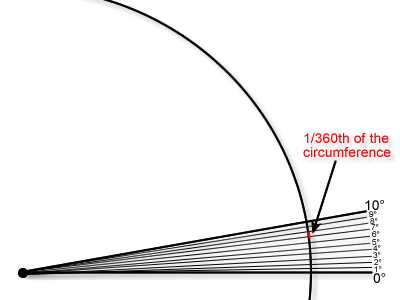
A common unit of angle measure is a degree. When we say that the measure of an angle is 1 degree, what is the meaning of this measurement? To answer this, consider the construction of the common protractor that measures angles in degrees, where 360 degrees mark off a circle's circumference (180 degrees mark off half of the circumference). A protractor that measures angles in degrees divides the circle's circumference into 360 equal parts, or arcs, with the distance between each tick mark equal to $${\large\frac{1}{360}}$$ of the circle's circumference.

Figure 7-10
A measure of 10 degrees always measures the same amount of openness between the two rays of an angle, which corresponds to $${\large\frac{{10}}{{360}}}$$ of the circle's circumference.

Degree
We have already observed that two cannons with different barrel lengths have the same angle measure if the amount of openness of the angle formed by tilting the cannon barrel up from the 3 o'clock position is the same for both cannons. As with cannons, the size of protractor used to measure the angles does not affect the angle measure. In Figure 7-11, both cannon barrels are tilted up from a 3 o'clock position by the same amount. Since the amount of openness between the 3 o'clock position and the cannon barrel is the same, it follows that the measure of these two angles is the same—they both have a measure of 60 degrees.

Figure 7-11
Is it possible to measure an angle's openness in inches or centimeters instead of degrees?
Think about it for a moment and then access this link ![]() to see our answers.
to see our answers.
No. The unit used to measure an angle must convey the fractional part or percent of a circle's circumference. If a number of inches or centimeters are used to measure the arc length cut off, this measurement will depend on the size of the circle centered at the vertex of the angle and does not convey the fractional part of the circle's circumference. However, using a unit (e.g., degrees or radians) that conveys the fractional part a circle's circumference assures that the angle measure will be the same regardless of the size of the circle that has the angle's vertex at its center.
What can we say about an angle that has a measure of 60 degrees?
Think about it for a moment and then access this link ![]() to see our answers.
to see our answers.
The rays of the angle cut off $${\large\frac{{60}}{{360}}}$$ or $$\large\frac{1}{6}$$ of any circle's circumference that has its center at the vertex of the angle.
Using the ‘Measuring Angles’ applet Below, answer the following questions:
![]()
Move the 'dot' on the circle to vary the angle.
As the openness of the angle is increased, how does the length of the arc subtended by the angle vary? How does the angle’s measure vary?
Think about it for a moment and then access this link ![]() to see our answers.
to see our answers.
As the openness of the angle is held constant, but the radius of the circle is increased, how does the length of the arc subtended by the angle vary? How does the angle’s measure vary?
Think about it for a moment and then access this link ![]() to see our answers.
to see our answers.
Why are the two displayed ratios alwaysequal?
Think about it for a moment and then access this link ![]() to see our answers.
to see our answers.